Saigon, 10 Years Later
As the plane descends over southern Vietnam, I observe braided rivers weaving across a canvas of mangroves and fish ponds, their silty waters glinting in the late afternoon sun. The semi-wild landscape below gives way to paddy fields, then the warehouses and factories of an industrial estate, a squiggly-shaped golf course, and expanding suburbia: empty plots of land bounded by small roads that carve out man-made patterns in asphalt.
It’s the end of March 2023, and Bama and I are bookending a trip to Quy Nhon on the country’s south-central coast with four nights in Saigon. This was where I made my first brief foray into Vietnam a decade earlier on a spontaneous family trip. I can’t quite put my finger on it, but something about the place instantly captivated me at the time. It may have had something to do with Saigon’s mercantile nature and inherent dynamism—I have a soft spot for bustling port cities—or the striking juxtaposition of old and new. Between the historic architecture dotting District 1 (the downtown area), the unexpected friendliness we encountered at every turn, and crispy Mekong Delta–style bánh xèo, I was certain it was only a matter of time before I came back.
At nightfall, Bama and I check in to a tiny hotel slash AirBnB at one end of a T-shaped residential alleyway. There are no staff members on duty inside the ground-floor communal lounge. Using the free Wi-Fi to check my phone, I find direct messages about our room number with instructions on where the key has been left for us to pick up. I’m also given a passcode for the front door and a separate key to open an outer steel gate should we wish to go out before 8 a.m., which we do.
Our first full day in Saigon begins with an early morning stroll through Lê Văn Tám Park, once a prestigious European cemetery for military men, wealthy civilians, and the colonial elite. After Vietnam was partitioned in the wake of the 1954 Geneva Accords, it was the place of choice to bury the who’s who of South Vietnamese society. Eventually the post-reunification government decreed in 1983 that all human remains would be disinterred and tombstones cleared from the site. And thus the city’s most distinguished resting place for the dead became a recreational zone for the living. Sure enough, we witness Saigon residents both young and old getting their fill of exercise: women jogging on shaded pathways circling the park, teenagers shooting hoops with friends, middle-aged men practicing the Southeast Asian sport of sepak takraw.
Having arrived from Jakarta less than 24 hours ago, we can’t help drawing immediate comparisons between the two cities. Saigon is blessed with plenty of green spaces in the older central districts, which are far more walkable and easier to navigate, thanks to a street grid laid down by French colonial administrators. Bama and I agree that the French put more effort into creating beautiful civic buildings than the Dutch ever did in Jakarta, where older structures tend to be whitewashed with little in the way of ornamentation. No Dutch-era place of worship back home can match the fairytale vision that is Saigon’s Tân Định Church, an 1870s landmark famed for its flamingo pink–and-white color scheme. Non-parishioners, understandably, are not allowed inside; we’re content with admiring the exterior details as a local couple stands on the porch for their pre-wedding photos. Over in District 1, another soon-to-be-married pair poses against the backdrop of a vintage convertible and the flamboyant facade of the Municipal Theater, originally the Opéra de Saïgon. They smile for the camera just as a bus disgorges a gaggle of European tourists in shorts and T-shirts.
At mealtimes, Google Maps points us the way to two excellent no-frills eateries a short walk from the hotel. Open to the street and marked by a bright yellow signboard, Mợ Út specializes in snakehead murrel (a freshwater fish) from the town of Châu Đốc beside the Vietnamese-Cambodian border. Breakfast here is a hearty bún chả cá—soup noodles with fishcake slices alongside a plate full of herbs, beansprouts, banana blossom, and lotus stem. (Bún đầu cá, noodles featuring meaty fish head served in another bowl, becomes our choice the next morning). After wandering down to City Hall and back, we duck into Quán Bún Thịt Nướng 88 for its heavenly namesake dish. This southern Vietnamese favorite is popular across the country for good reason: bún thịt nướng comprises an assortment of grilled pork, roasted peanuts, crispy spring rolls, and pickled carrot and radish, all placed atop cold rice vermicelli heaped over fresh greens. Lashings of fish sauce complete the mélange of flavors, and I also order freshly made gỏi cuốn (fresh spring rolls) to share.
Bama and I spend the afternoon at the Museum of History, whose galleries are filled with precious archaeological finds. There are Bronze Age Đông Sơn drums; classical Khmer relics taken by French colonialists from the temples of Angkor; and a preserved wooden stake driven into the riverbed to trap enemy ships at the 1288 Battle of Bạch Đằng, which halted the Mongol invasion of Vietnam. We admire intricately carved Cham statuary and artifacts from an ancient culture known today as Óc Eo, named after a village in the Mekong Delta where excavations have yielded Southeast Asia’s oldest surviving wooden sculptures.
Food and heritage continue to be dominant themes when we move to District 3 upon returning from Quy Nhon. Just around the corner from the French-colonial Archbishop’s Residence, Cơm quê Mười Khó is a rustic, semi-outdoor restaurant specializing in the rural cuisine of central Quảng Nam province. Its clever use of the leftover space between two buildings draws us in for a fabulous lunch centered on rice-flour pancakes from the district of Đại Lộc. Softened in a bowl of water, they morph into a wrapping for DIY rolls stuffed with barbecued pork, herbs, and vegetables (thịt xíu cuốn bánh tráng Đại Lộc). We also order stir-fried pumpkin flowers with garlic (bông bí xào tỏi), fig salad (gỏi trái vả), goby braised in a claypot (cá bống kho tộ), and bowls of fluffy white rice. All this is washed down with nước sả tắc đường phèn—a thirst-quenching iced drink of kumquat, lemongrass, and rock sugar.
One of the great joys of running a travel blog is meeting like-minded bloggers in real life. Len, the prolific writer-photographer behind Len Journeys, has graciously taken a day off work to show us around his home city. He picks us up at the hotel in a Grab car for an excursion into Districts 5 and 6, where we’re deposited in the heart of Cholon, the city’s centuries-old Chinatown. Though Len was born and bred in Saigon, he sheepishly admits that he’d never set foot inside the landmark market whose predecessor gave the area its Vietnamese name (Chợ Lớn literally means “Big Market”).
An influential figure who shaped the district’s development was Chinese entrepreneur Quách Đàm, who arrived in French Indochina in the 1880s as a young immigrant with hardly a penny to his name. His sharp business acumen and early investments eventually paid off over the subsequent decades. By 1916, Quách had risen to become a hugely successful rice merchant who owned three rice-husking mills around town and a fleet of Phnom Penh–based steamships plying the Mekong River. But he never forgot his humble roots and the poverty he endured during his early life. Apart from funding schools and hospitals, the millionaire philanthropist was instrumental in creating Cholon’s central Bình Tây Market: he donated the land alongside 58,000 francs (the equivalent of about US$204,000 in today’s terms) for its construction from 1926–28. Sadly, Quách never lived to see the finished building, as he died a little over a year before its inauguration.
From the upper level, we watch traders in the central courtyard lighting incense sticks and paying their respects in front of Quách Đàm’s bust. The sculpture is a more recent addition to an ornate marble fountain commissioned by his family in 1929. In contrast to my own whistlestop tour a decade ago that did not include any of the nearby temples, Len has budgeted ample time for us to soak up the feel of a neighborhood that, in his opinion, has changed little despite Vietnam’s ongoing economic boom.
In the streets I overhear snippets of Cantonese being spoken by elderly residents, spot signs in traditional Chinese characters, and pass air-dried lap cheong sausages strung up outside open storefronts. The familiarity reaches its peak when Len brings Bama and I to Quán chè Hà Ký, an old-school dessert spot known for zimaawu, the thick black sesame soup I grew up eating at big family dinners in Hong Kong. “This tastes like my childhood,” I tell Len. Tacked to the wall above our table is a laminated menu written in Vietnamese and Chinese, chock-full with classic Cantonese sweet treats whose ingredients I instantly recognize: jujube, lotus seed, water chestnut, and snow fungus. “I’m the only one here who can’t read this menu,” Bama jokes. Bánh ích trần mặn, the final item listed under what Len describes as the snack section, piques my curiosity. It turns out to be savory-sweet sticky rice dumplings of mung bean paste and dried shrimp. Topped with chopped scallion and cut into quarters, the morsel is served alongside fish sauce with thin crinkle-cut slices of pickled carrot and radish—a reminder of exactly where we are in Southeast Asia.
While in Cholon, the three of us hop between five historic places of worship. Most are within a few short blocks of one another. Bama and I wait for the sun to break through the clouds and light up the pastel-yellow facade of St. Francis Xavier Parish Church. It opened in 1902 for the local Chinese Catholic congregation, and while the church itself is neo-Gothic, there are also classical Chinese flourishes like a paifang gateway and a hexagonal pavilion for a statue of the Virgin Mary. Inside, the vaulted nave was where the unpopular South Vietnamese President Ngô Đình Diệm and his younger brother (both practicing Catholics) sought refuge before their assassinations during the CIA-backed coup of 1963.
The neighborhood’s temples traditionally doubled as meeting places for southern Chinese immigrant communities, each of which spoke different languages and brought their own customs and architectural traditions to Vietnam. Hokkien settlers from Fujian established both Hà Chương Assembly Hall (a Mazu temple) and the colorful, ornately decorated Quan Âm Pagoda dedicated to Guanyin, the Bodhisattva of compassion and mercy. Perhaps the most well-known religious site in Cholon is the Cantonese-style Thiên Hậu Temple, which dates to the early 19th century (though a sanctuary has stood on this site since around 1760). Stylistically, it’s a doppelgänger of the temples in Hong Kong’s older neighborhoods, where local fishermen have worshipped Tin Hau—the same sea goddess revered as Mazu by the Hokkien—for many generations. We wander below spiraling coils of incense, admiring the weathered ceramic dioramas on the roofs depicting Chinese mythology and scenes of city life in the Qing era. Inscribed on the sculpted base of a timber column is the old Cantonese name for Cholon, “Tai Ngon” (literally “Embankment”), and “Ox Horn Street.”
Just a few minutes’ walk down the road lies the newly renovated Guan Di Temple (a.k.a. Nghĩa An Assembly Hall). Built in 1819 by Teochew émigrés from the region around Chaozhou in eastern Guangdong province, the structure enshrines a red-faced statue of Guan Yu, a deified general who lived during the twilight years of the Han Dynasty. Schoolchildren across modern-day China know him as a powerful hero in the 14th-century historical novel Romance of the Three Kingdoms. After strolling past discarded timber beams piled up in the courtyard out front, the telltale smell of fresh paint greets us as we step over the temple’s threshold. Bama and I crane our necks at the exquisite woodcarvings now gleaming in vibrant colors, and take in intricately painted door gods that look as good as new. The time-worn Thien Hau Temple could do with a similar facelift.
As much as we love Cholon, lunch is waiting for us elsewhere. Len finds a Grab car to drop us outside Cục Gạch Quán, a cozy restaurant split between two French-colonial houses on a quiet street in the northern fringes of District 1. Created by local architect Trần Bình, it specializes in honest home-style Vietnamese cooking from the countryside. (Barely two months after our visit, Cuc Gạch Quán is recognized with a Bib Gourmand in the inaugural Michelin Guide to Hanoi and Ho Chi Minh City.) The menu here offers a dizzying variety of mostly vegetable dishes, with a whole page dedicated to different kinds of flowers that are steamed, sauteed, or cooked in soups. We’re soon introduced to canh chua, a well-balanced sour soup with a clear, tamarind-flavored broth sweetened by pineapple. The one Len orders for us to share has smooth fish balls and thick slices of spongy bạc hà (Indian taro) stalks. Porous and mild, the latter soaks up the soup’s addictive flavor.
We spend most of the ensuing afternoon at the Museum of Fine Arts. An air of neglect pervades the 1930s mansion originally built for the wealthiest family in town—the progeny of Chinese-born businessman and philanthropist Hui Bon Hoa. I can’t help noticing the stained-glass windows with broken panels and missing wrought iron frames by the beautiful spiral staircase in the annex. Inside the main building, dust gathers on a non-functioning vintage elevator, the first one ever installed in Saigon. This place has such good bones; a proper restoration in tandem with a more up-to-date rethink of the galleries would go a long way.
Then, from the museum’s front gate, Len takes us down what he calls a typical Saigon street. It’s lined with narrow multistory buildings housing walk-up apartments, potted plants on their balconies providing a welcome burst of green; the shops at ground level deal in antiques and other curios like replicas of Óc Eo and Cham statues. An older woman, shielded from the sun in a conical nón lá hat, carries a sagging bamboo pole across her shoulders. Hung from either end are baskets heaving with ingredients for a local dish I can’t identify. On the far side of a busy seven-lane boulevard, we amble through a rambling street market whose future is in doubt. “Land prices in this area are very high,” Len says with a hint of resignation. “The next time you come back, this might not be here anymore.” In business-minded Saigon, the wheels of progress never stop turning. ◊




















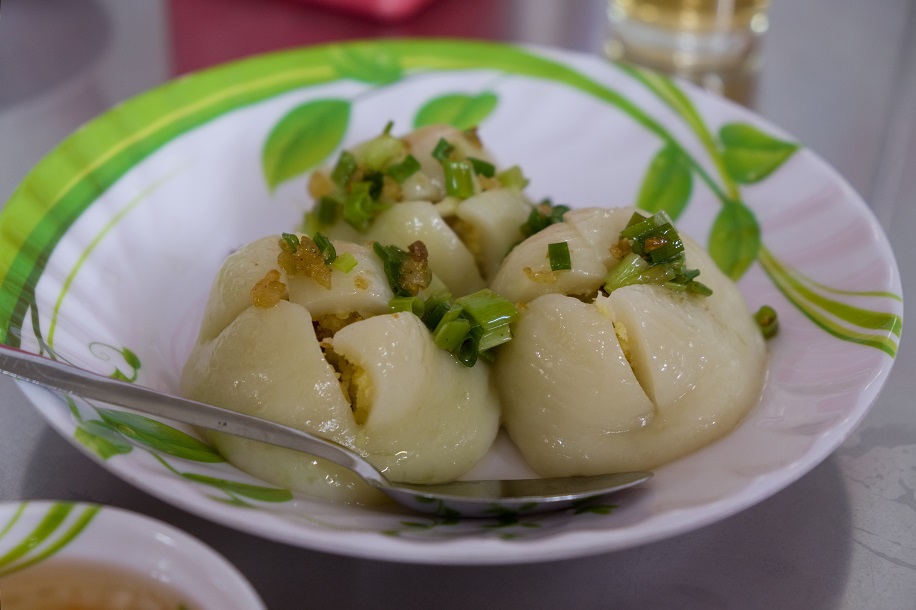


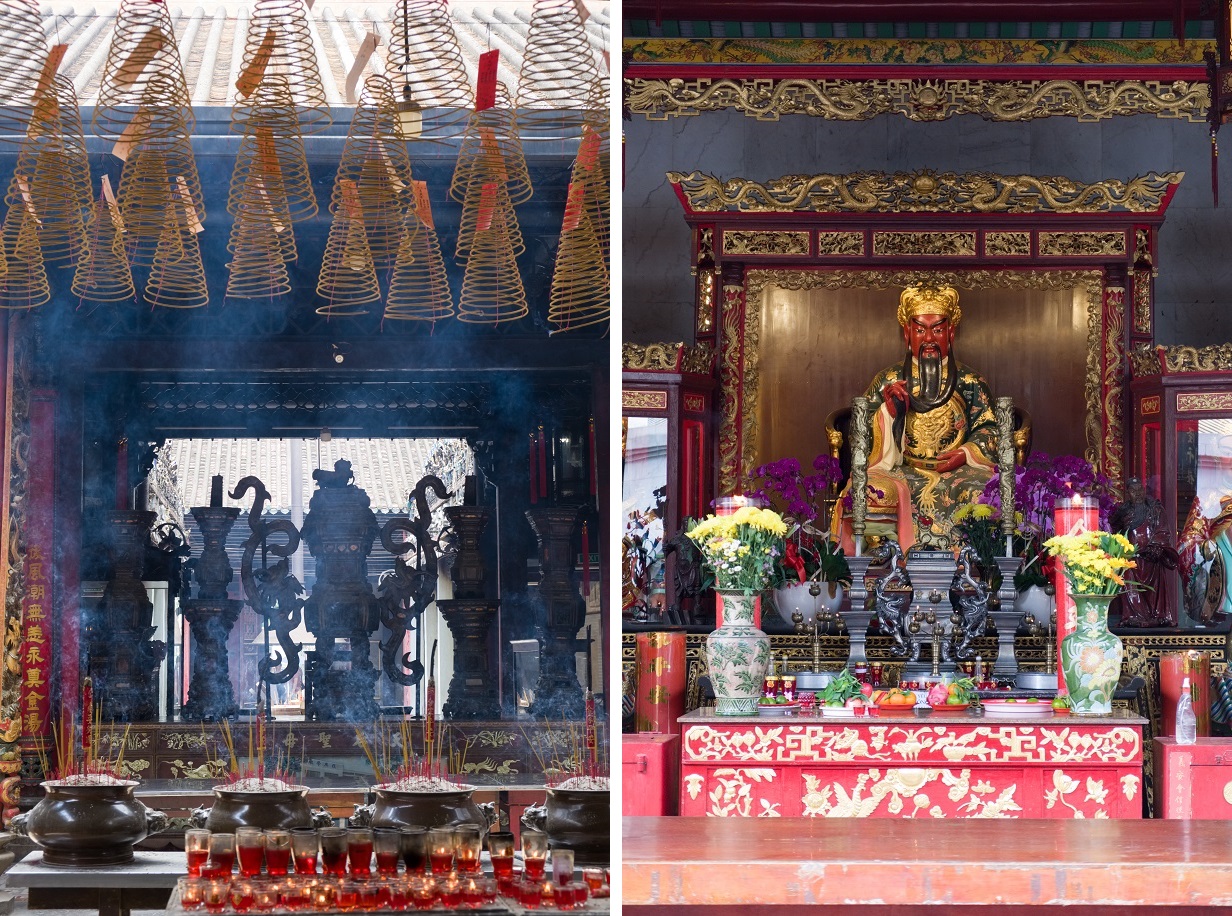
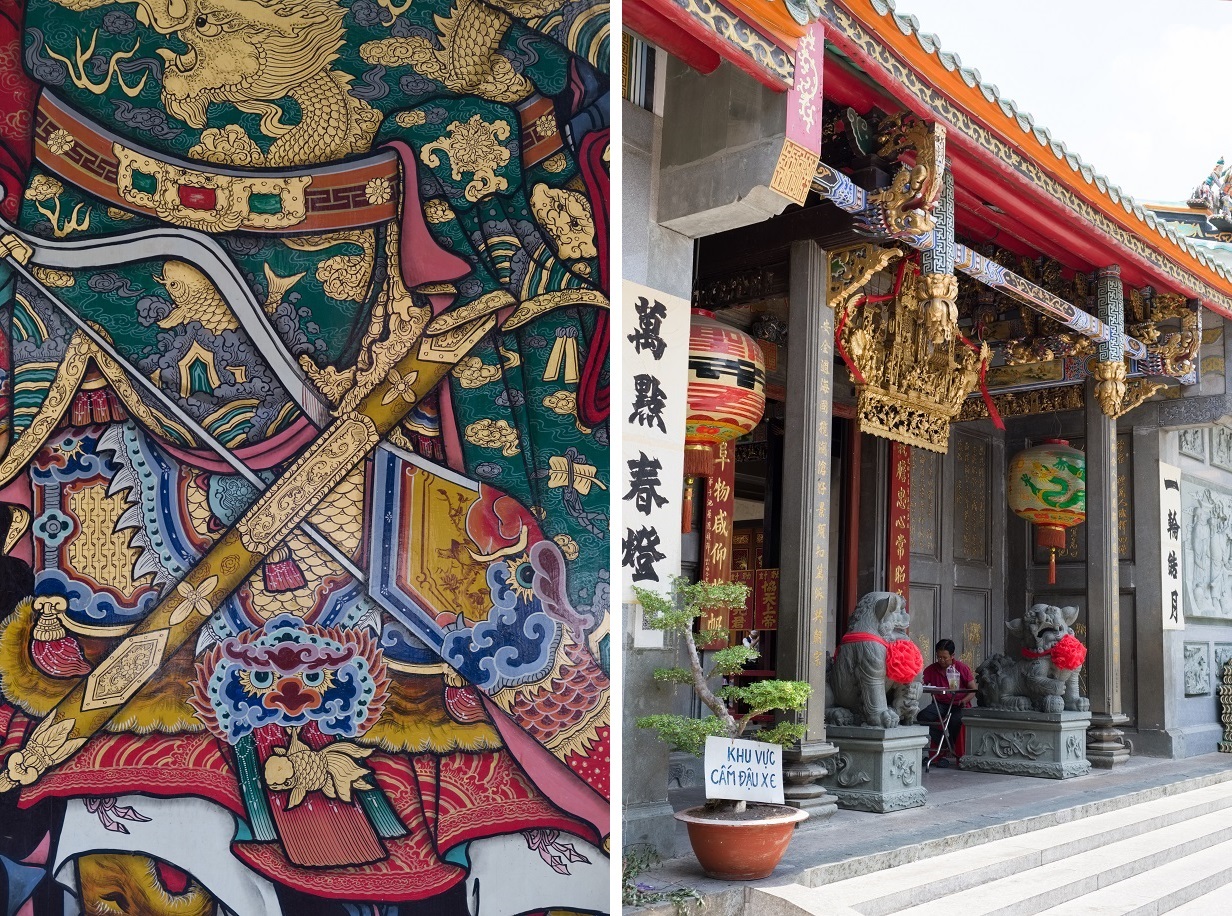
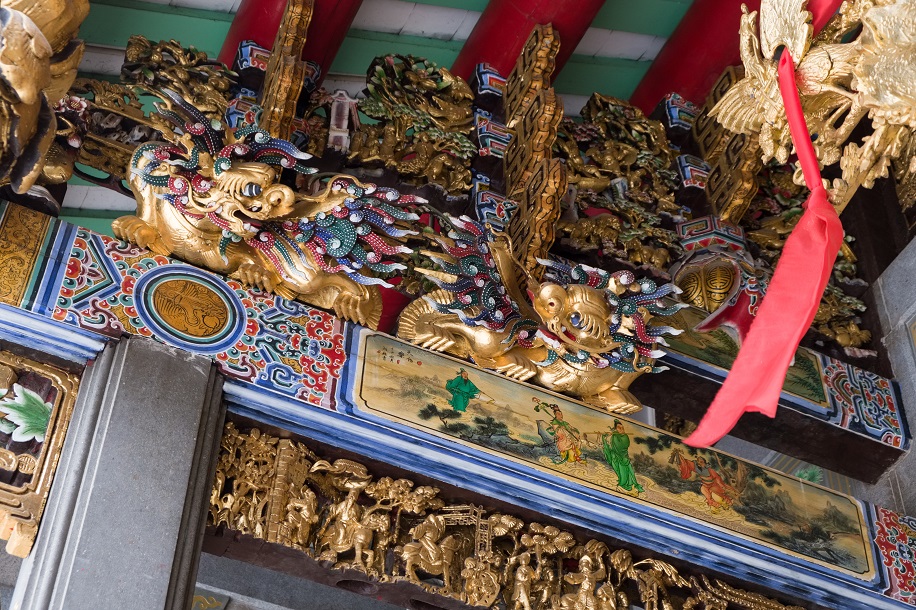





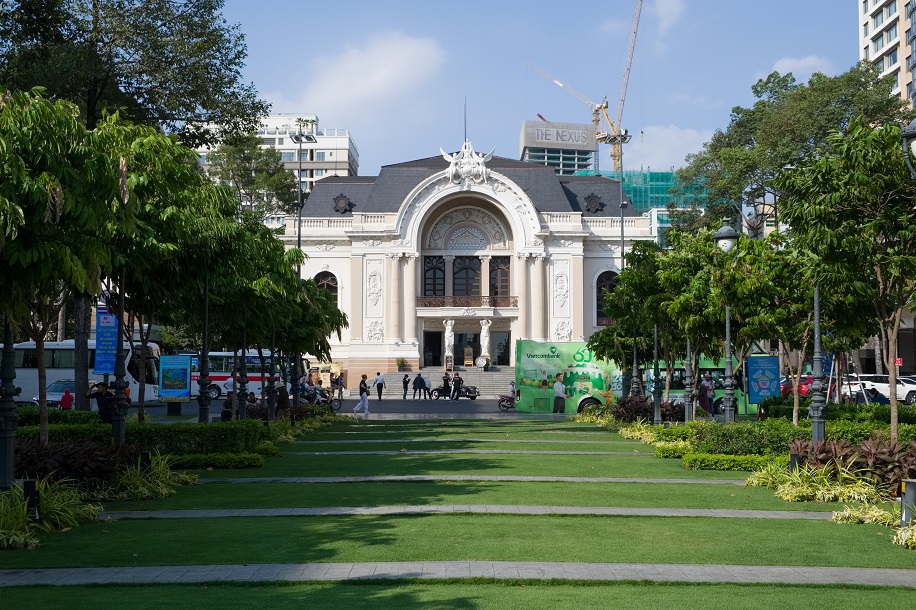






Looks like an attractive city to visit, thank you for your feedback.
You’re welcome—I hope you get the chance to visit Saigon sometime in the future. Thank you in turn for reading and leaving a comment.
You’ve definitely sold this place to me James! Such a great write up, and lovely photos. I haven’t been to Vietnam but it’s definitely on the cards in the future. And how wonderful you got to meet Len journeys! I adore and look forward to his blog posts just as I do yours and Bama’s. Good work mate! X
Anna, you are too kind! I wish I had the drive to publish stories as frequently as either Bama or Len. Of course, it doesn’t help that I tend to write such long posts!
Spending a day with Len was the real highlight of our time in Saigon. We wouldn’t have found that retro dessert place in Cholon or the fabulous Vietnamese restaurant without his guidance! I think you will love Saigon as much as we did… it’s a great city with so much soul and character.
Nobody can keep up with Bama when it comes to posting! 🤣🤣🤣
Actually the Bitexco Financial Tower reminds me of Stark Tower from the Marvels movies 😀
I hadn’t really thought of the similarity when I was there, but you are completely right! The striking profile and the partly cantilevered helipad make it a strong match.
Lovely photos and story about your visit to Saigon. I have only been once to Vietnam and only to Hanoi (on business in 1991!). Vietnam is on our long list of countries to visit sooner than later… Thanks for the virtual tour. (Suzanne)
My pleasure, Suzanne! It will be so interesting for you to return all these years later and see how Vietnam has changed. The funny thing is that I have been three times now, but never to Hanoi or the north. Perhaps next time…
Wow! This is a whole different world from my time in HCM City. I stayed not far from the Opera House with a brother and sister running an airbnb, and although they were super kind (and I still keep in touch with the sister), I was eager to get out of the sprawling city where I had to keep an eye on motor bike riders who often raced along the footpaths. Your post tempts me to return and explore some more because, yes, there were many majestic buildings and the people not only friendly but extra nice.
I guess the errant behavior (and the sheer number) of motorcyclists didn’t faze me because Jakarta is like that too. It’s so nice that you still keep in touch with that sister—I haven’t been so proactive with maintaining long-distance friendships with my college and high school buddies.
It was because she was and still is such a lovely person.
This was a smorgasbord of art, architecture, history, and of course, food! I was really bummed to not get to Saigon on my trip a year ago. We covered a decent amount of Vietnam but never made it here as we opted for some smaller places besides Hanoi. I guess I’ll have to go back like you did although I’m kind of hoping it won’t be ten years from now!
I really enjoyed delving a little deeper into Saigon and its older districts like Cholon. And ordering food at all those fantastic local places (with zero Vietnamese) wasn’t so challenging after all. Hanoi has eluded me for the longest time—I’ve never been north of Hue despite multiple trips to Vietnam, so it will be very interesting to compare Saigon to the capital when I do eventually make it there!
I must admit I had rather mixed feelings about Saigon from my first trip there in 2011. But after reading your blog post about it many years ago, I was intrigued and determined to return to the city one day. I remember thinking how walkable and leafy the downtown area was, and how good the dishes we tried were. That visit to the Museum of History before going to Quy Nhon was a good decision, for it gave us a glimpse into the unique artistic style of the Cham people. And of course, that cheese ice cream!
Bama, I agree about the good timing of our afternoon at the Museum of History. That gallery of ancient Cham and Óc Eo sculptures was my favorite one, and I guess the smaller space with Khmer carvings from Angkor surprised us both. I’m glad you had a change of heart on your second trip to Saigon!
What a wonderful trip around HCMC this was. The food! I am drooling. Vietnamese cuisine is among my fave, and we’re lucky to have really good restaurant just across the road for when I don’t feel like cooking. And how fabulous that you got to meet Len.
We only went there once. I don’t remember much except the traffic was terrifying (this even after having spent a lot of time in India, and also been to Ha Noi), and we went exploring in some very tiny residential alleys and to Cao Dai Temple. Clearly I have to go back!
Alison
Only one meal we had in Saigon turned out to be just okay rather than totally delicious – and that was partly my fault for picking a newish place near the hotel that looked interesting but had no Google reviews.
Living in Jakarta has dulled me to terrible traffic (and unruly motorists/motorcyclists) so Saigon felt pretty normal to me! That said, I did notice there was an even higher density of scooters on the road at rush hour.
What an absolutely wonderful write up and fabulous photos of this vibrant city. I have literally been back from three months of travel throughout Vietnam, not even a week, so your post instantly took me back. Thank you!
Thank you also for the kind words! How lucky you are to have spent three whole months traveling across Vietnam – I would love to do a similar journey someday, going overland from north to south and taking detours to more off-the-beaten-track destinations. One thing I especially miss is the incredible food!
Yes, that’s exactly what we did, except it was south to north then back again, travelling to many places we missed along the way. It was amazing and yes, I miss the food already!
Really enjoyed this post of you and Bama taking at trip to Saigon. And you caught up with Len! So amazing to catch up with fellow bloggers, and sounded like all three of you got along. It looked like a lot of historical artifacts at the Museum of History. Incredible you got to see some of South East Asia’s oldest surviving wooden sculptures, and how some of the finds were used in invasions. Loved reading about your food finds.
I can see why Chợ Lớn is translated to Big Market – so many shops and things to eat at Bình Tây Market. I think big markets like these are quite common in South East Asia. I had to laugh when Bama said he was the only one who couldn’t read the menu. But guessed he picked out the foods that were delicious 😄 It sounds like you really enjoyed the foods especially the ones that were similar to your childhood foods. Great photos as usual. Looking at all of them, Saigon looks so well maintained, looking traditional with a touch of modern. Hope you are doing well, James 😊
Cheers, Mabel! All is well here – I hope 2024 has been good to you so far. 🙂 Though it was a short stay, I enjoyed Saigon even more than the first time around all those years ago. Bama and I look forward to catching up with Len again one day in Indonesia or perhaps elsewhere in Southeast Asia. It’d be wonderful to show him around Jakarta if he decides to stop over for a few days.
It really is very nice to meet up with other bloggers. Very cool to see each other after talking online for ages. Hope Len visits you at some point and you and Bama can catch up again. It has been alright here. Wishing you well, James 🙂